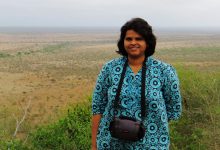Riddhika Kalle
Scientist
Salim Ali Centre for Ornithology and Natural History
India
Involved with the BOU as:
IBIS associate editor
BOU member since: 2017
Most likely to be found . . .
. . . unfortunately in my office, working on my laptop and finding an excuse to visit a field site.
What does being an IBIS associate editor involve?
It is professionally highly rewarding. It involves a great amount of expertise and commitment to ensure that the highest quality of research gets published in IBIS. It feels great being in the panel of top ornithologists and ecologists. I will ensure there is consistency in the quality of papers published. I handle a rigorous peer-review process by assigning experienced reviewers to papers and finally select papers on the basis of merit and appropriateness.
What do you enjoy most about being an IBIS associate editor?
I enjoy reading a variety of interesting papers by authors and, selecting the most suitable reviewers based on the appropriateness of the study and methods applied in ornithological research. One becomes exposed to the most advanced analytical techniques applied in avian research and this also keeps you well informed on ornithological findings around the world.
What would you say to anyone who is considering submitting a paper to IBIS?
The most important way to proceed is to first have a look at the kind of papers IBIS publishes. Send in your best bird paper to IBIS.
When did your interest in ornithology begin?
Since I was a child. I always loved animals and dreamt of working with them.
What is your most memorable bird-y experience?
Oh..there are so many. When I first saw the Heart-spotted Woodpecker at Sanjay Gandhi National Park; Malabar Pied Hornbill at Dandeli Wildlife Sanctuary; the beautiful Malabar Trogon (male) at Mudumalai Tiger Reserve; Common Rosefinch in the scrub jungles of South India; Secretary Bird at Kruger National Park; a large flock of magnificent Grey-crowned Cranes, the gorgeous Southern-red Bishop and several flocks of Long-tailed Widowbirds in the Midlands of South Africa.
What do you predict to be the future big research areas in ornithology?
Impact of changing climate and land cover on distributions of birds at large spatial scales, the ‘Big Data’ approach to developing country-wide species conservation plan and the application of long-term remote-sensing data to field research.
What would you say to anyone considering research in ornithology?
Go ahead! There is a lot of scope. It’s extremely fascinating. Start with knowing your backyard birds first. Read many natural history books and keenly observe their behaviour in the field in order to get a clear understanding of their ecology, before you raise your research questions and hypothesis. Data collection should include biologically meaningful variables with regards to your study species.
What are the big conservation challenges in the next decade?
Saving our endemic species; especially wetland birds from shrinking habitats, protecting and connecting resourceful forest patches in highly fragmented ecosystems and urban landscape planning to build connectivity for free movement and dispersal of birds.
Has your career in ornithology turned out how you expected it to?
Never thought of a career in ornithology but definitely wildlife sciences and I am happy and proud to experience it’s growth.
As an early career researcher, what do you hope to achieve within ornithology in the next 10 years?
To develop more citizen science based research projects as I feel this has been one of the best practical approaches to spreading conservation messages and awareness by involving local people.
View my Nalanda University profile
View my ResearchGate profile


